Reliable and Fast Genotyping Protocol for Galactosylceramidase (Galc) in the Twitcher (Twi) Mouse
Abstract
1. Introduction
2. Materials and Methods
2.1. Animal Procedures
2.2. DNA Extraction from Tail Biopsy
2.3. Genotyping of Galactosylceramidase (Galc) in the Twitcher (Twi) Mouse: Novel Protocol
2.3.1. Step 1: Set Up the PCR Reactions
- Calculate the number of reactions to be performed for each assay. Include at least a duplicate of each sample, NTCs, and if possible, known genomic DNA controls (1 WT, 1 HOM, and 1 HET) on each reaction plate. All DNA samples are assessed in a triplicate PCR reaction, plus three NTCs, as well as one animal HOM, one HET, and one WT always in triplicate.
- Gently swirl the bottle of the TaqPathTM ProAmpTM Master Mix with ROXTM to resuspend it. Caution: TaqPathTM ProAmpTM Master Mix with ROXTM contains glycerin. In case of skin and eye contact, rinse with water for several minutes. Read the material safety data sheet (MSDS) and follow the handling instructions. Wear appropriate protective eyewear, clothing, and gloves.
- Briefly, vortex and centrifuge the Custom TaqMan® SNP Genotyping Assay for the Galc gene (40X). Caution: Custom TaqMan® SNP Genotyping Assay contains formamide. Exposure causes eye, skin, and respiratory tract irritation. It is a possible developmental and birth defect hazard. Read the MSDS and follow the handling instructions. Wear appropriate protective eyewear, clothing, and gloves.
- Prepare the mix (without DNA) for the number of reactions according to Table 2, plus 10% overage into a microcentrifuge tube. Cap the tube.
- Mix the components thoroughly, then centrifuge briefly to spin down the contents and eliminate air bubbles.
- Pipette 5.5 μL of the reaction and mix into each well of an optical plate.
- Dilute 1 to 20 ng of each purified genomic DNA sample into nuclease-free water for a total sample volume of 4.5 μL (DNA concentration between 0.2–4.4 ng/μL). The final DNA concentration must be at least 0.2 ng/μL for each well reaction. Add 4.5 μL of the DNA of each animal in duplicate and in two wells add 4.5 μL of nuclease-free water for the NTC control. In our prototype experiment, we used 1 ng/μL. If using crude lysates, the sample volume must be up to 25% of the total reaction volume. Once the protocol is established, a fixed volume (as 1 μL) of the DNA sample can be used to simplify the procedure and reduce the time for genotyping as the qualitative part of the procedure. Critical: change tips between each sample to prevent cross-contamination.
2.3.2. Step 2: Set up and Run the Real-Time PCR Instrument
2.4. Genotyping Protocol for Galactosylceramidase (Galc) in the Twitcher (Twi) Mouse: The Most Widely Used Protocol
2.5. Galc Enzymatic Activity Assay
2.6. Motor Behavioral Experiment: Rotarod Test
2.7. Statistical Analysis
3. Results
3.1. Genotyping Protocol for Galactosylceramidase (Galc) in the Twitcher (Twi) Mouse: A Pilot Study
3.2. Galc Enzymatic Activity (HMU Assay) Corroborated the Mice Identification with the New Protocol of Genotyping
3.3. Genotyping Galactosylceramidase (Galc) in the Twitcher (Twi) Mouse: Verification Study
3.4. Comparison with the Mainly Used Protocol for Twitcher Genotyping
4. Discussion
Author Contributions
Funding
Institutional Review Board Statement
Informed Consent Statement
Data Availability Statement
Conflicts of Interest
References
- Wenger, D.A.; Escolar, M.L.; Luzi, P.; Rafi, M.A. Krabbe Disease (Globoid Cell Leukodystrophy); McGraw-Hill: Columbus, OH, USA, 2014. [Google Scholar] [CrossRef]
- Bradbury, A.M.; Bongarzone, E.R.; Sands, M.S. Krabbe disease: New hope for an old disease. Neurosci. Lett. 2021, 752, 135841. [Google Scholar] [CrossRef] [PubMed]
- Duchen, L.W.; Eicher, E.M.; Jacobs, J.M.; Scaravilli, F.; Teixeira, F. Hereditary leucodystrophyin the mouse: The new mutant Twitcher. Brain 1980, 103, 695–710. [Google Scholar] [CrossRef] [PubMed]
- White, S.J.; Cantsilieris, S. Genotyping Methods and Protocols. Methods Mol. Biol. 2017, 1492. [Google Scholar] [CrossRef]
- Available online: https://www.jax.org/strain/000845 (accessed on 9 September 2021).
- Sakai, N.; Inui, K.; Tatsumi, N.; Fukushima, H.; Nishigaki, T.; Taniike, M.; Nishimoto, J.; Tsukamoto, H.; Yanagihara, I.; Ozono, K.; et al. Molecular Cloning and Expression of cDNA for Murine Galactocerebrosidase and Mutation Analysis of the Twitcher Mouse, a Model of Krabbe’s Disease. J. Neurochem. 1996, 66, 1118–1124. [Google Scholar] [CrossRef] [PubMed]
- Kobayashi, T.; Yamanaka, T.; Jacobs, J.M.; Teixeira, F.; Suzuki, K. The Twitcher mouse: An enzymatically authentic model of human globoid cell leukodystrophy (Krabbe disease). Brain Res. 1980, 202, 479–483. [Google Scholar] [CrossRef] [PubMed]
- Jacquot, S.; Chartoire, N.; Piguet, F.; Herault, Y.; Pavlovic, G. Optimizing PCR for Mouse Genotyping: Recommendations for Reliable, Rapid, Cost Effective, Robust and Adaptable to High-Throughput Genotyping Protocol for Any Type of Mutation. Curr. Protoc. Mouse Biol. 2019, 9, e65. [Google Scholar] [CrossRef] [PubMed]
- Bonaparte, D.; Cinelli, P.; Douni, E.; Hérault, Y.; Maas, A.; Pakarinen, P.; Poutanen, M.; Lafuente, M.S.; Scavizzi, F. Federation of European Laboratory Animal Science Associations Working Group. FELASA guidelines for the refinement of methods for genotyping genetically-modified rodents: A report of the Federation of European Laboratory Animal Science Associations Working Group. Lab. Anim. 2013, 47, 134–145. [Google Scholar] [CrossRef] [PubMed]
- Allelic Discrimination Getting Started Guide Applied Biosystems 7300/7500/7500 Fast Real-Time PCR System. Available online: https://assets.thermofisher.com/TFS-Assets/LSG/manuals/cms_042315.pdf (accessed on 9 September 2021).
- TaqMan® SNP Genotyping Assays User Guide. Publication Number MAN0009593. ThermoFisher. Available online: https://tools.thermofisher.com/content/sfs/manuals/TaqMan_SNP_Genotyping_Assays_man.pdf (accessed on 9 September 2021).
- Terrell, K.A.; Rasmussen, T.A.; Trygg, C.; Bunnell, B.A.; Buck, W.R. Molecular beacon genotyping for globoid cell leukodystrophy from hair roots in the Twitcher mouse and rhesus macaque. J. Neurosci. Methods 2007, 163, 60–66. [Google Scholar] [CrossRef] [PubMed][Green Version]
- TaqPath TM ProAmp TM Master Mixes User Guide. Genotyping and Copy Number Variation PCR. Publication Number MAN0015758. ThermoFisher. Available online: https://assets.thermofisher.com/TFS-Assets/LSG/manuals/MAN0015758_TaqPathProAmpMMix_UG.pdf (accessed on 9 September 2021).
- Del Grosso, A.; Parlanti, G.; Angella, L.; Giordano, N.; Tonazzini, I.; Ottalagana, E.; Carpi, S.; Pellegrino, R.M.; Alabed, H.B.R.; Emiliani, C.; et al. Chronic lithium administration in a mouse model for Krabbe disease. JIMD Rep. 2021, 63, 50–65. [Google Scholar] [CrossRef] [PubMed]
- Del Grosso, A.; Galliani, M.; Angella, L.; Santi, M.; Tonazzini, I.; Parlanti, G.; Signore, G.; Cecchini, M. Brain-targeted enzyme-loaded nanoparticles: A breach through the blood-brain barrier for enzyme replacement therapy in Krabbe disease. Sci. Adv. 2019, 5, eaax7462. [Google Scholar] [CrossRef] [PubMed]
- Tonazzini, I.; Cerri, C.; Del Grosso, A.; Antonini, S.; Allegra, M.; Caleo, M.; Cecchini, M. Visual System Impairment in a Mouse Model of Krabbe Disease: The Twitcher Mouse. Biomolecules 2020, 11, 7. [Google Scholar] [CrossRef] [PubMed]
- Pellegrini, D.; Del Grosso, A.; Angella, L.; Giordano, N.; Dilillo, M.; Tonazzini, I.; Caleo, M.; Cecchini, M.; McDonnell, L.A. Quantitative Microproteomics Based Characterization of the Central and Peripheral Nervous System of a Mouse Model of Krabbe Disease. Mol. Cell. Proteom. 2019, 18, 1227–1241. [Google Scholar] [CrossRef] [PubMed]
- Wiederschain, G.; Srinivasa, R.; Kolodny, E. Characterizationof6-hexadecanoylamino-4- methylumbelliferyl-b-D-galactopyranoside as fluorogenic substrate of galactocerebrosidase for the diagnosis of Krabbe disease. Clin. Chim. Acta 1992, 205, 87–96. [Google Scholar] [CrossRef] [PubMed]
- Lin, D.; Fantz, C.R.; Levy, B.; Rafi, M.A.; Vogler, C.; Wenger, D.A.; Sands, M.S. AAV2/5 vector expressing galactocerebrosidase ameliorates CNS disease in the murine model of globoid-cell leukodystrophy more efficiently than AAV2. Mol. Ther. 2005, 12, 422–430. [Google Scholar] [CrossRef] [PubMed]
- Graziano, A.C.E.; Cardile, V. History, genetic, and recent advances on Krabbe disease. Gene 2015, 555, 2–13. [Google Scholar] [CrossRef] [PubMed]
- Cinelli, P.; Rettich, A.; Seifert, B.; Burki, K.; Arras, M. Comparative analysis and physiological impact of different tissue biopsy methodologies used for the genotyping of laboratory mice. Lab. Anim. 2007, 41, 174–184. [Google Scholar] [CrossRef] [PubMed]
- Signorini, C.; Cardile, V.; Pannuzzo, G.; Graziano AC, E.; Durand, T.; Galano, J.M.; De Felice, C. Increased isoprostanoid levels in brain from murine model of Krabbe disease—Relevance of isoprostanes, dihomo-isoprostanes and neuroprostanes to disease severity. Free Radic. Biol. Med. 2019, 139, 46–54. [Google Scholar] [CrossRef] [PubMed]
- Słomka, M.; Sobalska-Kwapis, M.; Wachulec, M.; Bartosz, G.; Strapagiel, D. High Resolution Melting (HRM) for High-Throughput Genotyping-Limitations and Caveats in Practical Case Studies. Int. J. Mol. Sci. 2017, 18, 2316. [Google Scholar] [CrossRef] [PubMed]
- Carpi, S.; Del Grosso, A.; De Sarlo, M.; Colagiorgio, L.; Scaccini, L.; Tonazzini, I.; Parlanti, G.; Cecchini, M. Data from: Reliable and fast genotyping protocol for galactosylceramidase (GALC) in the Twitcher (Twi) mouse. Dryad 2022. [Google Scholar] [CrossRef]
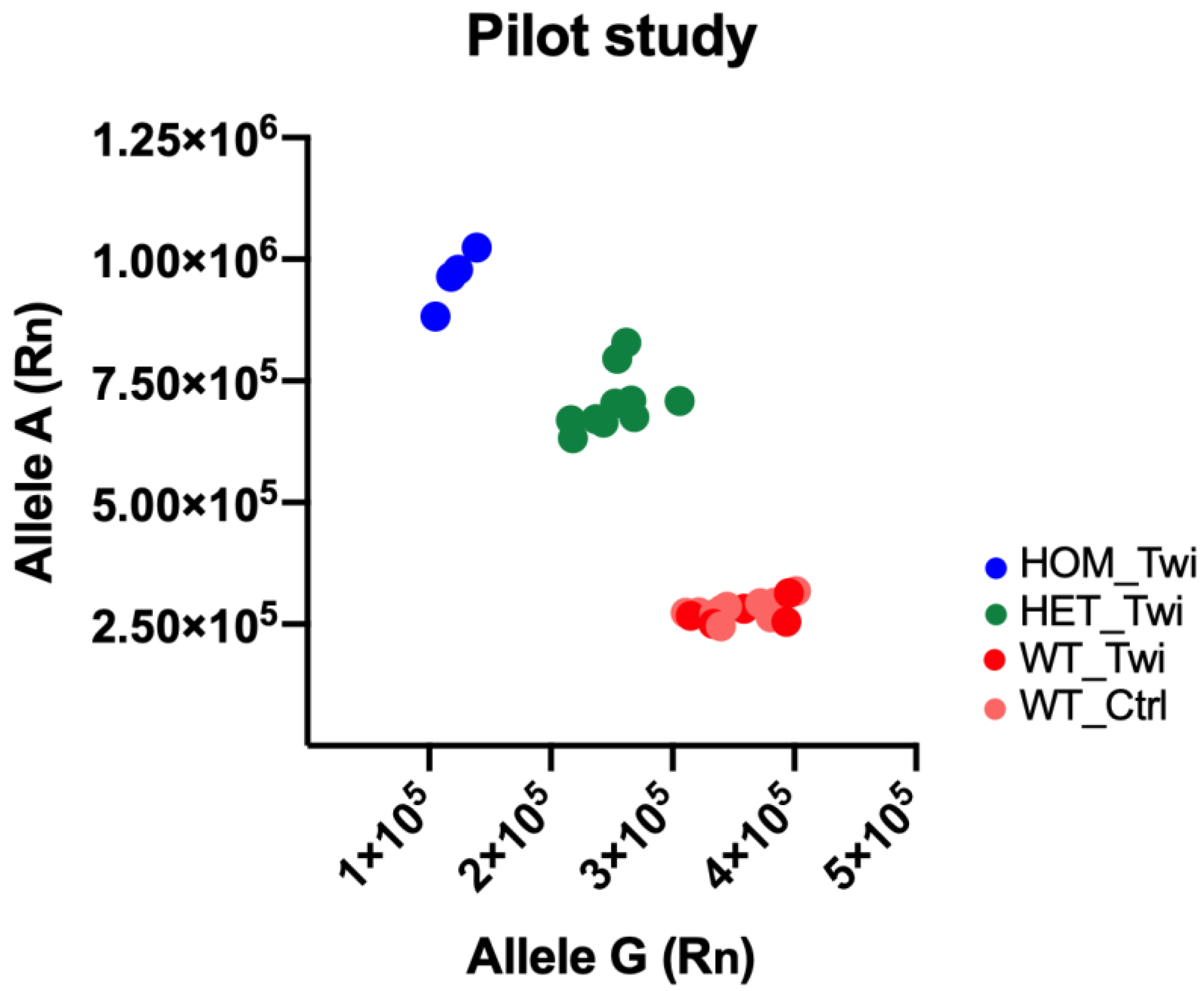

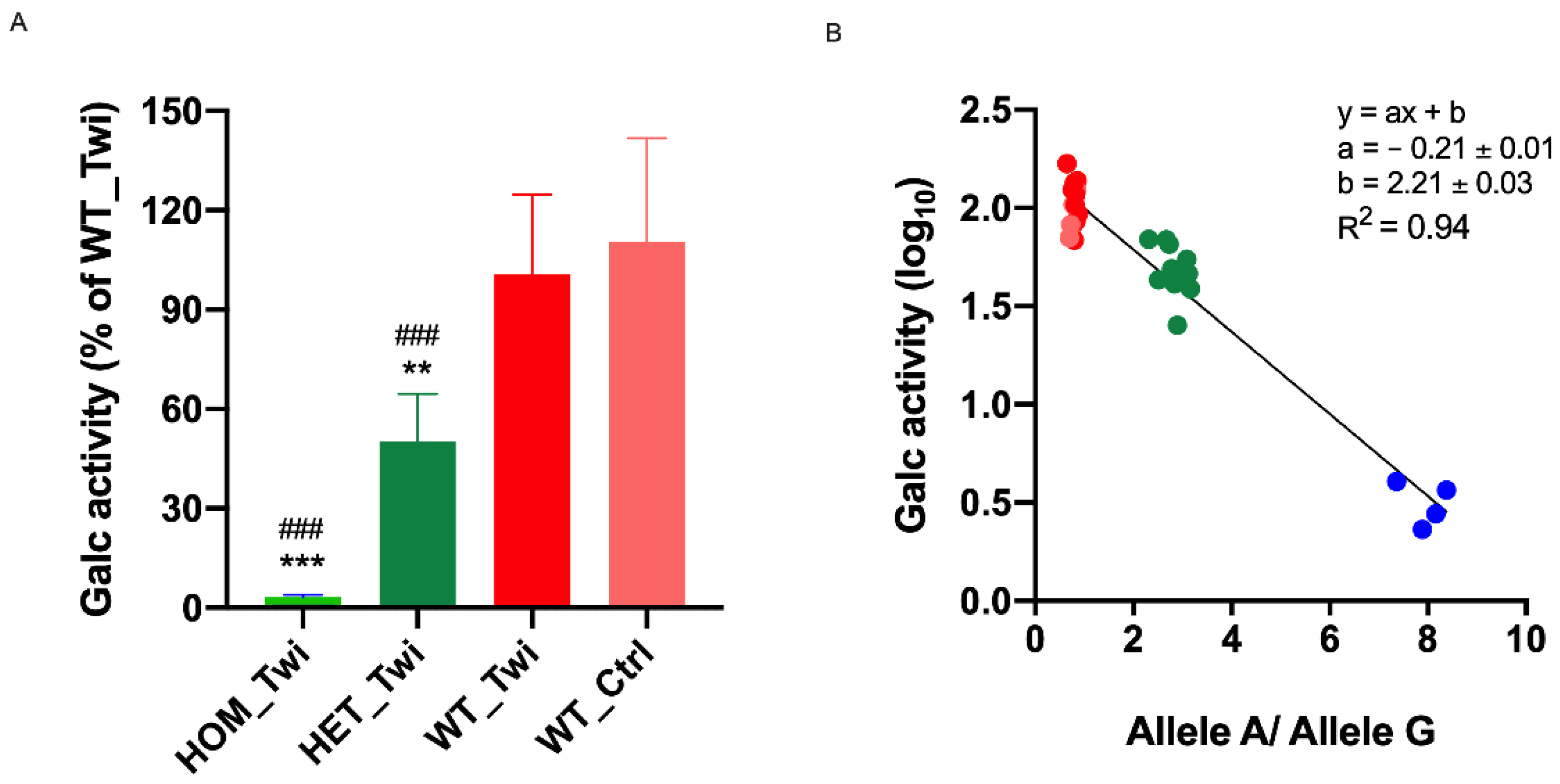
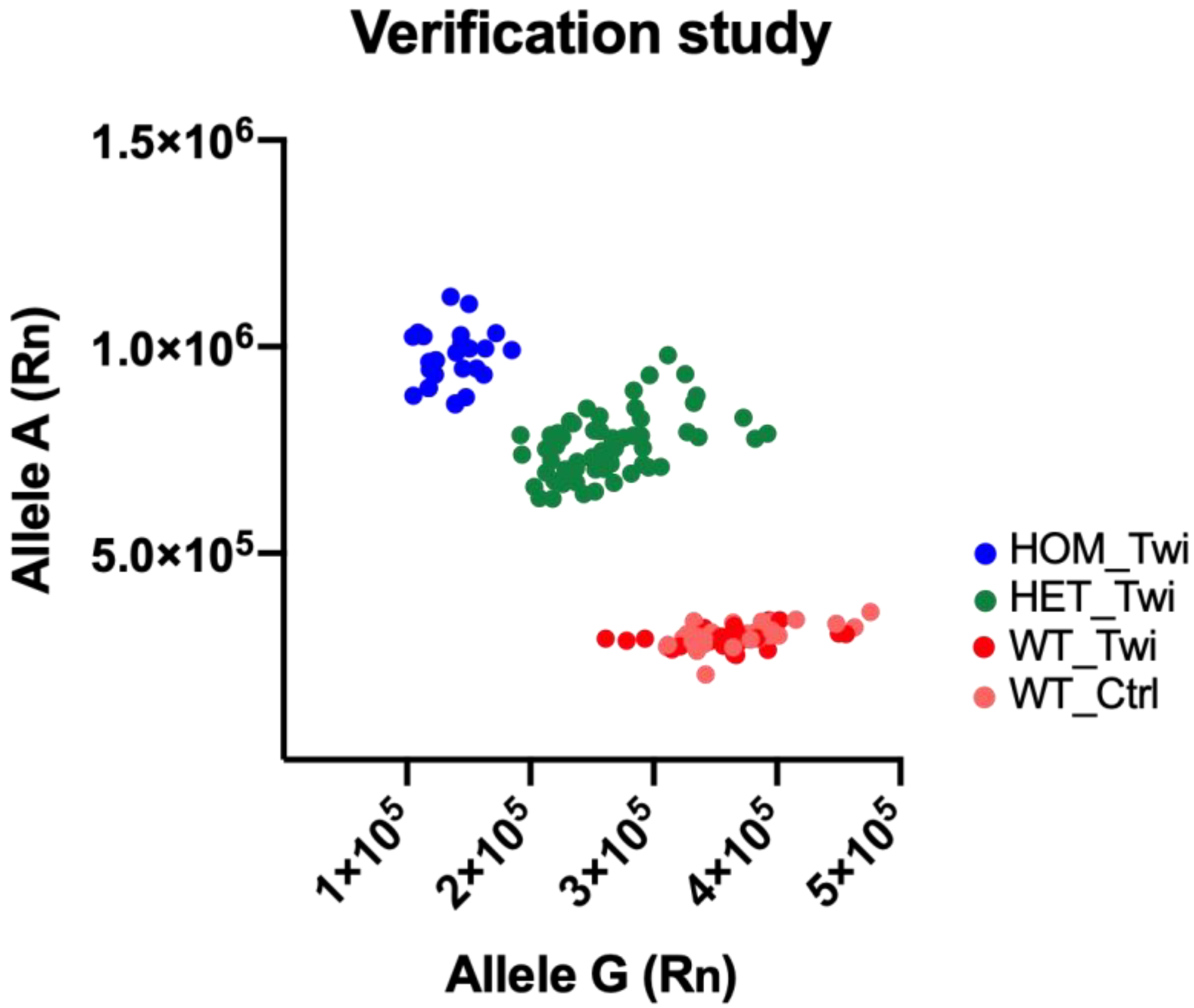
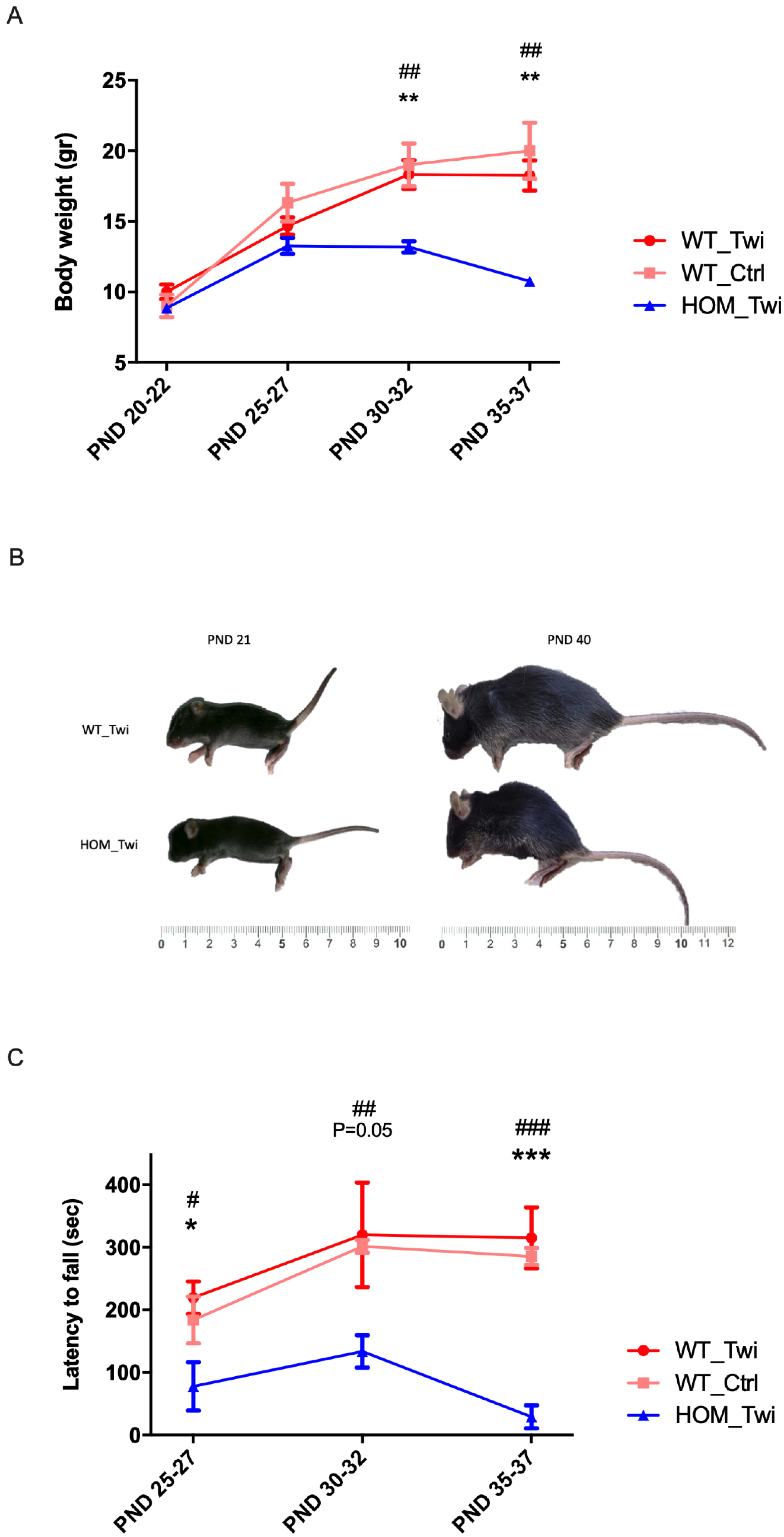
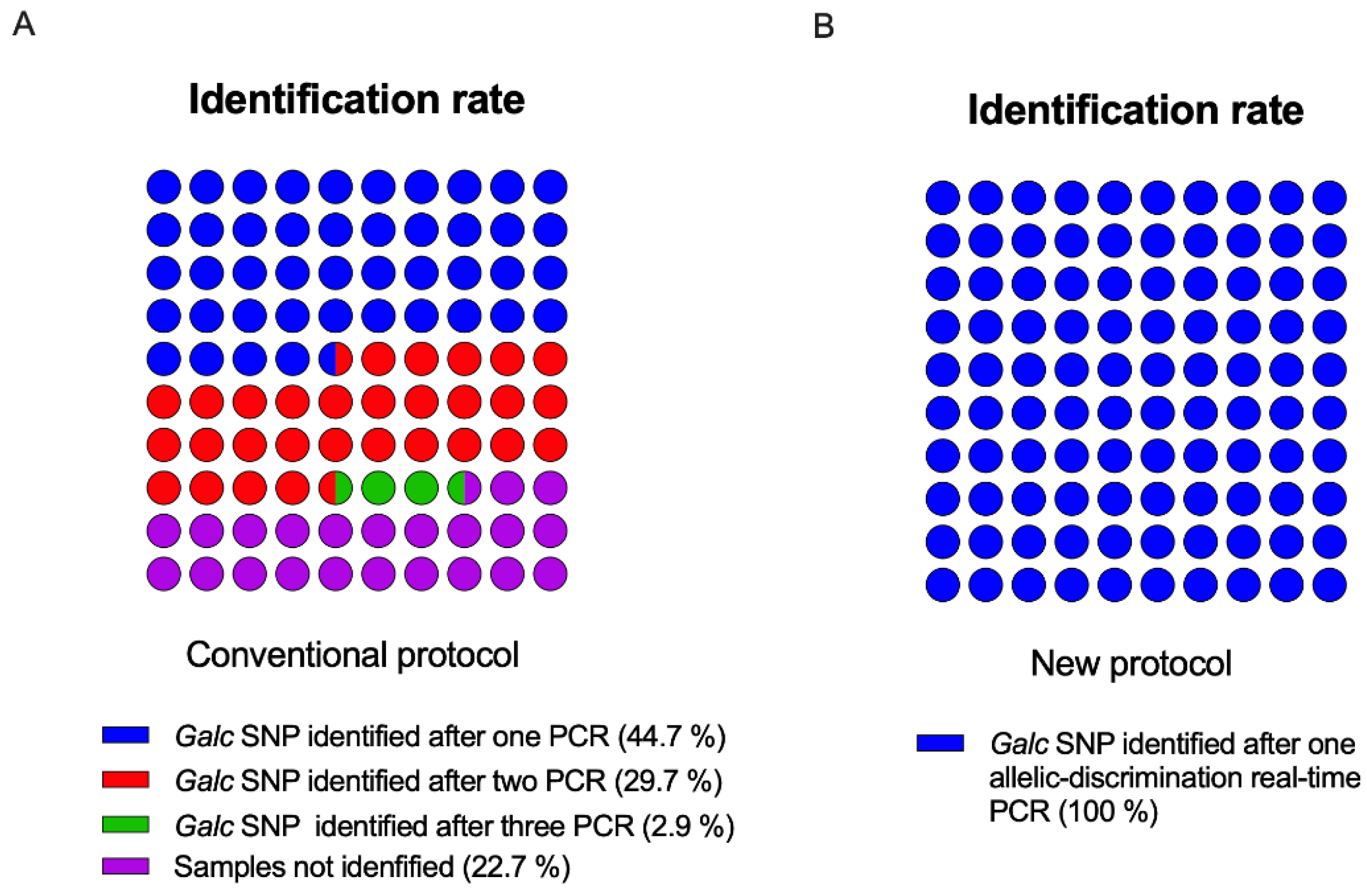
| Name | Sequences |
|---|---|
| Forward Primer | CTGCTTAGAATCAATCAGACTG |
| Reverse Primer | CTCAACAACGGACAATTACC |
| Probe 1 (allele G)-VIC-MGB Dye | CCAGGCTGGTATTACCTGG |
| Probe 2 (allele A)-FAM-MGB Dye | CCAGGCTGATATTACCTGG |
| Context Sequence | AAATGAGTTGGTCCGAC[C/T]ATAATGGACTTCTGTCAC |
| Component | Volume per Reaction | Volume per Reaction Plus 10% Overage |
|---|---|---|
| TaqPathTM ProAmpTM Master Mix with ROXTM | 5 μL | 5.5 μL |
| Custom TaqMan® SNP Genotyping Assay for Galc gene (40X) | 0.25μL | 0.275 μL |
| Nuclease-free water | 0.25 μL | μL |
| Step Number | Step | Temperature | Time | Cycles |
|---|---|---|---|---|
| 1# | Pre-read | 60 °C | 30 s | Hold |
| 2# | Initial denature / Enzyme activation | 95 °C | 5 min | Hold |
| Denature | 95 °C | 15 s | 40 | |
| Anneal/Extend | 60 °C | 1 min | ||
| 3# | Post-read | 60 °C | 30 s | Hold |
Publisher’s Note: MDPI stays neutral with regard to jurisdictional claims in published maps and institutional affiliations. |
© 2022 by the authors. Licensee MDPI, Basel, Switzerland. This article is an open access article distributed under the terms and conditions of the Creative Commons Attribution (CC BY) license (https://creativecommons.org/licenses/by/4.0/).
Share and Cite
Carpi, S.; Del Grosso, A.; De Sarlo, M.; Colagiorgio, L.; Scaccini, L.; Tonazzini, I.; Parlanti, G.; Cecchini, M. Reliable and Fast Genotyping Protocol for Galactosylceramidase (Galc) in the Twitcher (Twi) Mouse. Biomedicines 2022, 10, 3146. https://doi.org/10.3390/biomedicines10123146
Carpi S, Del Grosso A, De Sarlo M, Colagiorgio L, Scaccini L, Tonazzini I, Parlanti G, Cecchini M. Reliable and Fast Genotyping Protocol for Galactosylceramidase (Galc) in the Twitcher (Twi) Mouse. Biomedicines. 2022; 10(12):3146. https://doi.org/10.3390/biomedicines10123146
Chicago/Turabian StyleCarpi, Sara, Ambra Del Grosso, Miriam De Sarlo, Laura Colagiorgio, Luca Scaccini, Ilaria Tonazzini, Gabriele Parlanti, and Marco Cecchini. 2022. "Reliable and Fast Genotyping Protocol for Galactosylceramidase (Galc) in the Twitcher (Twi) Mouse" Biomedicines 10, no. 12: 3146. https://doi.org/10.3390/biomedicines10123146
APA StyleCarpi, S., Del Grosso, A., De Sarlo, M., Colagiorgio, L., Scaccini, L., Tonazzini, I., Parlanti, G., & Cecchini, M. (2022). Reliable and Fast Genotyping Protocol for Galactosylceramidase (Galc) in the Twitcher (Twi) Mouse. Biomedicines, 10(12), 3146. https://doi.org/10.3390/biomedicines10123146











